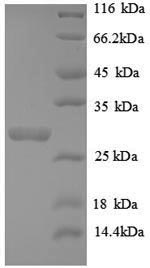Recombinant Human Telomerase protein component 1 (TEP1) is produced using an E. coli expression system and comes with a 6xHis-tag attached to the N-terminus, which makes purification more straightforward. This product contains a partial protein sequence that spans amino acids 2-226. SDS-PAGE analysis confirms the purity exceeds 90%, which appears suitable for various research applications. This protein is strictly for research use—not intended for diagnostic or therapeutic purposes.
TEP1 is part of the telomerase complex, a cellular machinery that seems crucial for maintaining telomeres—those protective caps found at chromosome ends. The protein likely contributes to telomere length regulation and stability, processes that may be vital for cellular aging and replication. Research on cellular longevity and aging-related mechanisms often focuses on this component.
Potential Applications
Note: The applications listed below are based on what we know about this protein's biological functions, published research, and experience from experts in the field. However, we haven't fully tested all of these applications ourselves yet. We'd recommend running some preliminary tests first to make sure they work for your specific research goals.
Based on the provided information, recombinant human TEP1 is produced in an E. coli expression system as a partial fragment (2-226aa) with an N-terminal 6xHis-tag. TEP1 is a complex eukaryotic protein that requires precise folding and proper integration into the telomerase complex for its biological function in telomere maintenance. E. coli expression systems cannot provide the necessary eukaryotic folding environment and may lack the chaperones required for correct folding of this multidomain protein. The partial nature of the fragment (approximately 25% of full-length TEP1) may not fold independently as it would in the context of the full-length protein. Purity >90% by SDS-PAGE is determined under denaturing conditions and does not confirm native folding or bioactivity. No validation data (e.g., complex formation assays, circular dichroism) are provided. Therefore, the protein's folding status and bioactivity cannot be confirmed and are likely compromised.
1. Protein-Protein Interaction Studies
If correctly folded (unverified), this TEP1 fragment could be used to study interactions with other telomerase components, as the His-tag facilitates immobilization for pull-down assays. However, if misfolded (probable in E. coli), interaction domains may be altered, leading to non-specific binding or failure to recognize genuine biological partners, compromising the validity of identified interactions within the telomerase complex.
2. Antibody Development and Validation
This application is suitable as antibody generation primarily relies on linear epitope recognition, which is independent of folding status. The defined fragment (2-226aa) provides specific epitopes for antibody production. However, antibodies generated against a potentially misfolded protein may not optimally recognize conformation-dependent epitopes of native TEP1 in biological contexts.
3. Structural and Biochemical Characterization
If properly folded, the fragment could be used for limited structural studies of the N-terminal region. However, if misfolded, biophysical data would misrepresent the native protein's properties. The partial nature of the fragment limits insights into the full-length TEP1 structure and domain organization.
4. His-Tag Affinity-Based Assays
The His-tag enables technical feasibility for immobilization-based assays regardless of folding status. However, if misfolded, screening results may not reflect biological relevance, as the protein's binding sites may be altered or inaccessible in their native conformation.
Final Recommendation & Action Plan
This E. coli-expressed partial TEP1 fragment requires validation before functional applications due to the high probability of misfolding. Recommended actions: (1) Validate folding through biophysical methods (circular dichroism for secondary structure, size-exclusion chromatography for oligomeric state); (2) Test functionality through interaction assays with known TEP1 binding partners if available; (3) For reliable results, consider eukaryotic expression systems that support proper folding or use full-length constructs; (4) Antibody development can proceed but requires validation against native protein; (5) Avoid functional studies until proper folding is confirmed. Always include appropriate controls and consider the limitations of studying isolated domains rather than full-length protein complexes.






